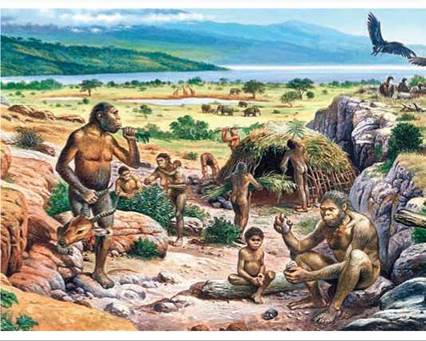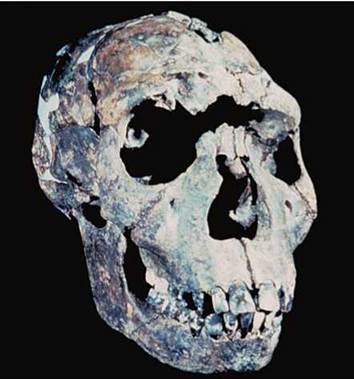THE LIVING WORLD
Unit Five. Evolution of Animal Life
21. How Humans Evolved
21.5. African Origin: Early Homo
The first humans evolved from australopithecine ancestors about 2 million years ago. The exact ancestor has not been clearly defined but is commonly thought to be A. afarensis. Only within the last 30 years have a significant number of fossils of early Homo been uncovered. An explosion of interest has fueled intensive field exploration in the last few years, and new finds are announced yearly; every year, our picture of the base of the human evolutionary tree grows clearer.
Homo habilis
In the early 1960s, stone tools were found scattered among homi- nid bones close to the site where A. boisei had been unearthed. Although the fossils were badly crushed, painstaking reconstruction of the many pieces suggested a skull with a brain volume of about 680 cubic centimeters (cc), larger than the australopithecine range of 400 to 550 cubic centimeters. Because of its association with tools (figure 21.6), this early human was called Homo habilis, meaning “handy man.” Partial skeletons discovered in 1986 indicate that H. habilis was small in stature, with arms longer than legs and a skeleton so similar to Australopithecus that many researchers at first questioned whether this fossil was human.

Figure 21.6 Homo habilis.
An artist's rendition of what Homo habilis may have looked like. Larger brain size and the use of tools distinguish Homo habilis from australopithecines.
Homo rudolfensis
In 1972, Richard Leakey, working east of Lake Rudolf in northern Kenya, discovered a virtually complete skull about the same age as H. habilis. The skull, 1.9 million years old, had a brain volume of 750 cubic centimeters and many of the characteristics of human skulls—it was clearly human and not australopithecine. Some anthropologists assign this skull to H. habilis, arguing it is a large male. Other anthropologists assign it to a separate species, H. rudolfensis, because of its substantial brain expansion.
Homo ergaster
Some of the early Homo fossils being discovered do not easily fit into either of these species. They tend to have even larger brains than H. rudolfensis, with skeletons less like an australopithecine and more like a modern human in both size and proportion. Interestingly, they also have small cheek teeth, as modern humans do. Some anthropologists have placed these specimens in a third species of early Homo, H. ergaster (ergaster is from the Greek word for “workman”), shown in figure 21.7.

Figure 21.7. Homo ergaster.
This skull of a boy, who apparently died in early adolescence, is 1.6 million years old and has been assigned to the species Homo ergaster. Much larger than earlier hominids, he was about 1.5 meters in height and weighed approximately 47 kilograms.
How Diverse Was Early Homo?
Because so few fossils have been found of early Homo, there is lively debate about whether they should all be lumped into H. habilis or split into the two species H. rudolfensis and H. habilis. If the two species designations are accepted, as increasing numbers of researchers are doing, then it would appear that Homo underwent an adaptive radiation (as described in chapter 14) with H. rudolfensis, the most ancient species, followed by H. habilis. Because of its modern skeleton, H. ergaster is lumped with H. erectus and is thought to be the most likely ancestor to later species of Homo.
Key Learning Outcome 21.5. Early species of Homo, the oldest members of our genus, had a distinctly larger brain than australopithecines and most likely used tools. There may have been several different species.